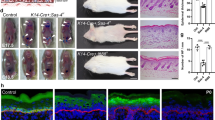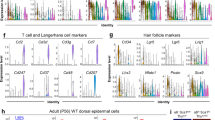Abstract
The regeneration of wounded stratified epithelium is accomplished via the migration of keratinocytes from the margins of the wound. However, the process of keratinocyte migration on the wound surface and the role of epithelial stem cells during re-epithelialization remain to be elucidated. Therefore, we administered BrdU to embryonic mice and generated epithelial defects on the buccal mucosa of these mice at two weeks after birth, using CO2 laser irradiation, with which we removed the entire thickness of the epithelium. In the unwounded epithelium, cytokeratin 14, p63, and BrdU were localized within the basal layer of the epithelium, but the majority of cells within the regenerated epithelium were immunopositive for these proteins. PCNA-negative and BrdU-positive basal keratinocytes, which evidence a slow cell cycle, were localized solely within the basal layer of the unwound epithelium facing the tips of dermal papillae. After laser irradiation, these basal keratinocytes facing the tips of the papillae evidenced positive immunoreactivity for PCNA, in addition to BrdU. These results indicate that epithelial stem cells of oral mucosa may be localized in the basal layer of the epithelium facing the tips of dermal papillae, and may migrate laterally with other basal keratinocytes in response to external stimuli.





Similar content being viewed by others
References
Aida J, Izumiyama-Shimomura N, Nakamura KI, Ishikawa N, S S Poon S, Kammori M, Sawabe M, Arai T, Matsuura M, Fujiwara M, Kishimoto H, Takubo K (2008) Basal cells have longest telomeres measured by tissue Q-FISH method in lingual epithelium. Exp Gerontol (in press)
Bamberger C, Hafner A, Schmale H, Werner S (2005) Expression of different p63 variants in healing skin wounds suggests a role of p63 in reepithelialization and muscle repair. Wound Repair Regen 13:41–50
Breuss JM, Gallo J, DeLisser HM, Klimanskaya IV, Folkesson HG, Pittet JF, Nishimura SL, Aldape K, Landers DV, Carpenter W, Gillett N, Sheppard D, Matthay MA, Albelda SM, Kramer RH, Pytela R (1995) Expression of the beta 6 integrin subunit in development, neoplasia and tissue repair suggests a role in epithelial remodeling. J Cell Sci 108:2241–2251
Cavani A, Zambruno G, Marconi A, Manca V, Marchetti M, Giannetti A (1993) Distinctive integrin expression in the newly forming epidermis during wound healing in humans. J Invest Dermatol 101:600–604
Chen Z, de Paiva CS, Luo L, Kretzer FL, Pflugfelder SC, Li DQ (2004) Characterization of putative stem cell phenotype in human limbal epithelia. Stem Cells 22:355–366
Cotsarelis G, Cheng SZ, Dong G, Sun TT, Lavker RM (1989) Existence of slow-cycling limbal epithelial basal cells that can be preferentially stimulated to proliferate: implications on epithelial stem cells. Cell 57:201–209
Clark RA, Ashcroft GS, Spencer MJ, Larjava H, Ferguson MW (1996) Re-epithelialization of normal human excisional wounds is associated with a switch from alpha v beta 5 to alpha v beta 6 integrins. Br J Dermatol 135:46–51
Cooper D, Schermer A, Sun TT (1985) Classification of human epithelia and their neoplasms using monoclonal antibodies to keratins: strategies, applications, and limitations. Lab Invest 52:243–256
Haapasalmi K, Zhang K, Tonnesen M, Olerud J, Sheppard D, Salo T, Kramer R, Clark RA, Uitto VJ, Larjava H (1996) Keratinocytes in human wounds express alpha v beta 6 integrin. J Invest Dermatol 106:42–48
Henry G, Li W, Garner W, Woodley DT (2003) Migration of human keratinocytes in plasma and serum and wound re-epithelialisation. Lancet 361:574–576
Heyden A, Huitfeldt HS, Koppang HS, Thrane PS, Bryne M, Brandtzaeg P (1992) Cytokeratins as epithelial differentiation markers in premalignant and malignant oral lesions. J Oral Pathol Med 21:7–11
Hosokawa R, Urata MM, Ito Y, Bringas P Jr, Chai Y (2005) Functional significance of Smad2 in regulating basal keratinocyte migration during wound healing. J Invest Dermatol 125:1302–1309
Kaur P, Li A (2000) Adhesive properties of human basal epidermal cells: an analysis of keratinocyte stem cells, transit amplifying cells, and postmitotic differentiating cells. J Invest Dermatol 114:413–420
Krawczyk WS (1971) A pattern of epidermal cell migration during wound healing. J Cell Biol 49:247–263
Kurokawa I, Mizutani H, Kusumoto K, Nishijima S, Tsujita-Kyutoku M, Shikata N, Tsubura A (2006) Cytokeratin, filaggrin, and p63 expression in reepithelialization during human cutaneous wound healing. Wound Repair Regen 14:38–45
Lajtha LG (1979) Stem cell concepts. Differentiation 14:23–34
Laplante AF, Germain L, Auger FA, Moulin V (2001) Mechanisms of wound reepithelialization: hints from a tissue-engineered reconstructed skin to long-standing questions. FASEB J 15:2377–2389
Laurikkala J, Mikkola ML, James M, Tummers M, Mills AA, Thesleff I (2006) p63 regulates multiple signalling pathways required for ectodermal organogenesis and differentiation. Development 133:1553–1563
Lavker RM, Sun TT (1982) Heterogeneity in epidermal basal keratinocytes: morphological and functional correlations. Science 215:1239–1241
Lehrer MS, Sun TT, Lavker RM (1998) Strategies of epithelial repair: modulation of stem cell and transit amplifying cell proliferation. J Cell Sci 111:2867–2875
Martin P (1997) Wound healing-aiming for perfect skin regeneration. Science 276:75–81
Mills AA, Zheng B, Wang XJ, Vogel H, Roop DR, Bradley A (1999) p63 is a p53 homologue required for limb and epidermal morphogenesis. Nature 398:708–713
Moll R, Franke WW, Schiller DL, Geiger B, Krepler R (1982) The catalog of human cytokeratins: patterns of expression in normal epithelia, tumors and cultured cells. Cell 31:11–24
Morris RJ, Potten CS (1994) Slowly cycling (label-retaining) epidermal cells behave like clonogenic stem cells in vitro. Cell Prolif 27:279–289
Morris RJ, Potten CS (1999) Highly persistent label-retaining cells in the hair follicles of mice and their fate following induction of anagen. J Invest Dermatol 112:470–475
Nakamura T, Endo K, Kinoshita S (2007) Identification of human oral keratinocyte stem/progenitor cells by neurotrophin receptor p75 and the role of neurotrophin/p75 signaling. Stem Cells 25(3):628–638
Ouhayoun JP, Gosselin F, Forest N, Winter S, Franke WW (1985) Cytokeratin patterns of human oral epithelia: differences in cytokeratin synthesis in gingival epithelium and the adjacent alveolar mucosa. Differentiation 30:123–129
Parsa R, Yang A, McKeon F, Green H (1999) Association of p63 with proliferative potential in normal and neoplastic human keratinocytes. J Invest Dermatol 113:1099–1105
Patel GK, Wilson CH, Harding KG, Finlay AY, Bowden PE (2006) Numerous keratinocyte subtypes involved in wound re-epithelialization. J Invest Dermatol 126:497–502
Pelissier A, Ouhayoun JP, Sawaf MH, Forest N (1992) Changes in cytokeratin expression during the development of the human oral mucosa. J Periodontal Res 27:588–598
Purkis PE, Steel JB, Mackenzie IC, Nathrath WB, Leigh IM, Lane EB (1990) Antibody markers of basal cells in complex epithelia. J Cell Sci 97:39–50
Quinlan RA, Schiller DL, Hatzfeld M, Achtstatter T, Moll R, Jorcano JL, Magin TM, Franke WW (1985) Patterns of expression and organization of cytokeratin intermediate filaments. Ann N Y Acad Sci 455:282–306
Senoo M, Pinto F, Crum CP, McKeon F (2007) p63 is essential for the proliferative potential of stem cells in stratified epithelia. Cell 129:523–536
Smith KL, Dean SJ (1998) Tissue repair of the epidermis and dermis. J Hand Ther 11:95–104
Tabata MJ, Matsumura T, Liu JG, Wakisaka S, Kurisu K (1996) Expression of cytokeratin 14 in ameloblast-lineage cells of the developing tooth of rat, both in vivo and in vitro. Arch Oral Biol 41:1019–1027
Taylor G, Lehrer MS, Jensen PJ, Sun TT, Lavker RM (2000) Involvement of follicular stem cells in forming not only the follicle but also the epidermis. Cell 102:451–461
Usui ML, Underwood RA, Mansbridge JN, Muffley LA, Carter WG, Olerud JE (2005) Morphological evidence for the role of suprabasal keratinocytes in wound reepithelialization. Wound Repair Regen 13:468–479
Watt FM (2001) Stem cell fate and patterning in mammalian epidermis. Curr Opin Genet Dev 11:410–417
Watanabe S, Osumi M, Ohnishi T, Ichikawa E, Takahashi H (1995) Changes in cytokeratin expression in epidermal keratinocytes during wound healing. Histochem Cell Biol 103:425–433
Woodley DT (1996) Re-epithelialisation. In: Clark RAF (ed) The molecular and cellular biology of wound repair, 2nd edn. Plenum Press, London, pp 339–354
Yang A, Schweitzer R, Sun D, Kaghad M, Walker N, Bronson RT, Tabin C, Sharpe A, Caput D, Crum C, McKeon F (1999) p63 is essential for regenerative proliferation in limb, craniofacial and epithelial development. Nature 398:714–718
Acknowledgments
We would like to thank Mr. T. Hara (Panasonic Dental Inc., Osaka, Japan) for his technical support. This work was supported by the Korea Science and Engineering Foundation (KOSEF) grant funded by the Korea government (MOST); Grant number: No. M106-46020003-07N4602-00310.
Author information
Authors and Affiliations
Corresponding author
Electronic Supplementary Material
418_2008_499_MOESM1_ESM.ppt
Supplemental figure 1. Two major theories of keratinocyte migration model during re-epithelialization process. a Leap-frogging theory suggests that suprabasal keratinocytes at the margin of the wound epithelium migrate over adherent basal keratinocytes. These cells downregulate their desmosomal attachment and revert to more characteristic basal keratinocytes. b Tractor-tread theory suggests that basal keratinocytes migrate on the wound surface and pull the remaining suprabasal keratinocytes. Arrows indicate the direction of keratinocyte movement. (PPT 518kb)
Rights and permissions
About this article
Cite this article
Hosoya, A., Lee, JM., Cho, SW. et al. Morphological evidence of basal keratinocyte migration during the re-epithelialization process. Histochem Cell Biol 130, 1165–1175 (2008). https://doi.org/10.1007/s00418-008-0499-3
Accepted:
Published:
Issue Date:
DOI: https://doi.org/10.1007/s00418-008-0499-3




